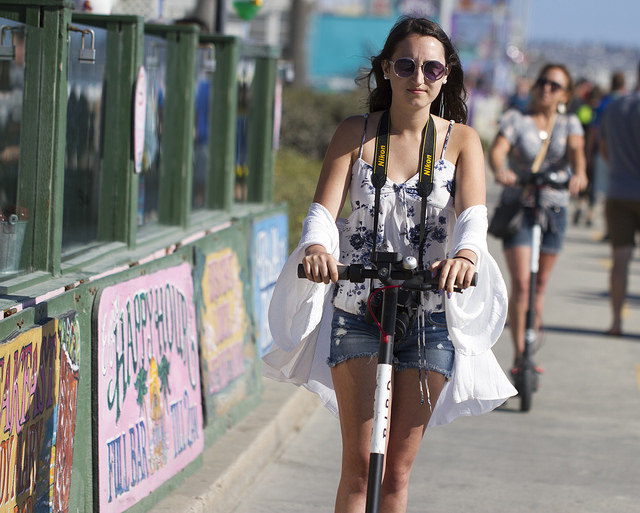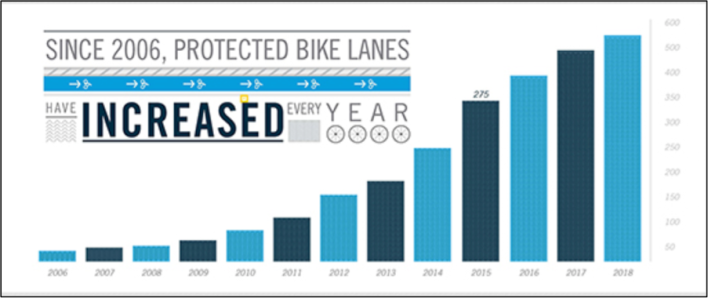The Transportation Research Board’s 99th Annual Meeting will be held in Washington, D.C. from Jan. 12-16, 2020. Click here for more information.
Scooter injuries are up more than 200 percent over the last four years — but everyone is blaming the wrong people.
The Jan. 8 report from JAMA Surgery does not offer much context for the 222-percent increase in scooter fatalities between 2014 and 2018, which has allowed news outlets to fill the gap with alarmist articles decrying the lack of scooter regulation, lack of helmet usage, and more.
Here's what's really going on:
1. Scooters are still new — and scooter injuries are, too.
When you're tripping over a poorly parked Jump on the sidewalk outside your apartment, it's easy to forget that scooter-share hasn't always been with us. But the first company to unleash its fleet on a city street, Bird, only made its American debut in Santa Monica in September 2017. That's a full three years into the period studied by JAMA. In the years prior to Bird's launch, most e-scooter injuries were suffered by private scooter owners; it wasn't until you could rent one with a few swipes on your cell phone that the public even had the opportunity to ride a scooter, much less be injured by this essentially new form of public transportation.
Or as Lime Communications Manager Russell Murphy elegantly put it: "I would posit that there was probably a rise in car crashes between the year before the Model-T and the year after the Model-T.”
2. Scooter ridership has boomed. Scooter infrastructure hasn't.
The rise of the e-scooter has been meteoric, eclipsing bike share usage nationally in 2018, just a year after gaining widespread availability, according to a recent report by NACTO, a national association of city officials. But that doesn't mean the scooters had anywhere to go — except onto roadways where drivers believe they are the sole legitimate user.
These charts suggest anew that protected bike lane construction hasn't kept pace with the rate at which Americans are hopping on the micromobility bandwagon.
As Streetsblog has reported countless times, protected bike lanes (or "individual transport lanes," or "micromobility lanes," or whatever you want to call them) lead to a drastic decrease in cyclist injuries. E-scooters are still new enough that no dedicated study has yet been performed on whether the same is true for their riders, but companies like Lime aren't waiting around for the data to take action.
"Protected bike lanes are the best way to reduce both bike and scooter injuries," Lime VP and Global Head of Trust and Safety Nick Shapiro said in a statement. His company is helps cities build safe infrastructure for scooters so riders don't have to dodge cars and also supports bicycle and pedestrian organizations through its Lime Hero program.
3. No one's talking about the role of cars in e-scooter injuries — still.
Perhaps the most disappointing revelation of the JAMA study had to do with what wasn't included in the report at all: local crash reports are so bad that researchers have have no way of knowing whether an e-scooter rider was injured after being forced into fast-moving traffic with multi-ton steel machines or simply got a little tipsy and crashed him or herself into a tree.
What we do have are decades of statistics about last century's hot new micro-vehicle: the bicycle. Those stats show that, on average, 30 percent of all bicycle crash injuries occur when the cyclist is hit by by a car. And as Oslo all but proved this year when it eliminated nearly all roadway deaths, every one of those crashes is preventable with a Vision Zero approach — whether it involves a bicycle, an e-scooter, or a micromobility option yet to be invented. (Hoverboard share, anyone?)
4. Injury reports get e-scooters banned — even when they don't tell the whole story.
In a sane world, the JAMA surgery report would prompt cities to take a long, hard look at how the infrastructure they’ve built is failing non-drivers. We do not live in a sane world.
Elizabeth, N.J. made headlines recently when it ended a pilot program with Lime after 16-year-old scooter-rider Nelson Gomez was killed by a truck driver.
Other cities have also leveraged out-of-context crash reports into instant bans on scooters — even if regulating dangerous vehicles like tow-trucks would be a more logical response.
The JAMA report did not recommend solutions for reversing the scooter injury trend, but the study authors did call for “improved rider safety measures and regulation.” That’s exactly the kind of vague suggestion that cities have historically reacted to with partial or outright bans, harmful helmet laws and additional rider restrictions.
One city that bucked this trend recently is Atlanta, which reacted to a spike in scooter injuries by committing to triple the Peachtree City's protected bike lanes by 2021. Will other cities follow their lead?
In the end, the JAMA report is important for one crucial reason: scooters are helping reduce car trips, and car trips are the single-biggest detriment to road safety.
Murphy, the Lime spokesman, claims that 25 to 50 percent of the company's trips replaced a trip that would have been made in a car. For now, that still leaves a lot of scooter riders at risk. But eventually, it could leave a lot of cars remaining in the garage.








